|

Installation of the samadhi
On the 15th of August 2010, 30 days after the
passing-away of Sripad Aindra Prabhu, the installation of his
samadhi took place in his room which got renovated and
covered with fresh cow dung. All the Deities were moved back in
and a small ceremony was held establishing his samadhi.
Some of his God-brothers were present and they glorified his
services and activities. Gopal Prabhu - on behalf of the
devotees of the 24-hour kirtana department - placed
Aindra Prabhu's sacred ashes into samadhi and also took
part in performing the various final rites led by the head-pujari
Mukunda Datta Prabhu. Besides his ashes, Aindra Prabhu's japa-mala,
his glasses and other personal belongings were
put into the
samadhi-pinda. After that, a fire sacrifice was held in
which 108
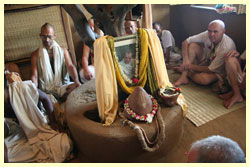 maha-mantras were chanted and thereafter, a
Vaishnava-homa was performed. After the rites were
completed, all the devotees present proceeded down to Mukunda
Datta Prabhu's house where a bhoga-offering took place
and the maha-prasadam got distributed. maha-mantras were chanted and thereafter, a
Vaishnava-homa was performed. After the rites were
completed, all the devotees present proceeded down to Mukunda
Datta Prabhu's house where a bhoga-offering took place
and the maha-prasadam got distributed.
Room No. 89
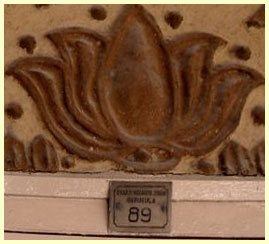 Soon after arriving in Vrindavan in the 1980’s, Sripad Aindra
Prabhu moved into room No. 89 of the brahmacari-ashram
and continued to stay there for 24 years. His room depicts the
Vrindavan mood: Cow dung art (gobbar) decorates the walls
(personally done by him), the floor is covered with clay from
the Yamuna and the remnants of the original Tamal tree from the
temple courtyard are placed in its centre. Aindra Prabhu would
only leave his room to come down for his kirtana
services, Deity dressing services, to purchase bhoga for
his Deities, for going to the bathroom and very rarely for other
purposes. Most of his time, he spent in his room chanting many
rounds, writing on his book, studying Srila Prabhupada’s books and the Goswami
literatures as well as performing his personal Deity worship. It
was Aindra Prabhu's desire that his samadhi be placed
nearby his Deities and that the worship of over 2'000
saligrama-silas, his Nitai-Sacisuta and all his other
Deities go on as he was doing. Soon after arriving in Vrindavan in the 1980’s, Sripad Aindra
Prabhu moved into room No. 89 of the brahmacari-ashram
and continued to stay there for 24 years. His room depicts the
Vrindavan mood: Cow dung art (gobbar) decorates the walls
(personally done by him), the floor is covered with clay from
the Yamuna and the remnants of the original Tamal tree from the
temple courtyard are placed in its centre. Aindra Prabhu would
only leave his room to come down for his kirtana
services, Deity dressing services, to purchase bhoga for
his Deities, for going to the bathroom and very rarely for other
purposes. Most of his time, he spent in his room chanting many
rounds, writing on his book, studying Srila Prabhupada’s books and the Goswami
literatures as well as performing his personal Deity worship. It
was Aindra Prabhu's desire that his samadhi be placed
nearby his Deities and that the worship of over 2'000
saligrama-silas, his Nitai-Sacisuta and all his other
Deities go on as he was doing.
“My room is
nitya-Navadvipa!”
In one room conversation, Aindra Prabhu is mentioning how his
room is in fact non-different from Navadvipa due to the direct
presence of Nitai-Sacisuta. He is saying:
“My room is Navadvipa! My room is
non-different from nitya-Navadvipa in the
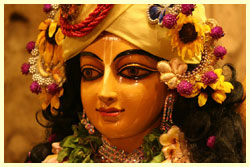 spiritual world. (…)
Navadvipa means in
Goloka. My room is Goloka.
And anyone who doubts it is a fool!
Non-different from Goloka. My room is non-
different from Navadvipa-dhama.
Gaura-Nitai are really there. They are real!
They are the Lords of nitya-Navadvipa.
Try to understand! As much as Navadvipa is non-different from Vrindavan, so Vrindavana is non-different
from Navadvipa. It’s a question of
the position of the heart. You’re performing sankirtana-yajña for the pleasure
of Lord Caitanya and Lord Nityananda in
Vrindavan-dhama, you’ll be
remembering Navadvipa.” spiritual world. (…)
Navadvipa means in
Goloka. My room is Goloka.
And anyone who doubts it is a fool!
Non-different from Goloka. My room is non-
different from Navadvipa-dhama.
Gaura-Nitai are really there. They are real!
They are the Lords of nitya-Navadvipa.
Try to understand! As much as Navadvipa is non-different from Vrindavan, so Vrindavana is non-different
from Navadvipa. It’s a question of
the position of the heart. You’re performing sankirtana-yajña for the pleasure
of Lord Caitanya and Lord Nityananda in
Vrindavan-dhama, you’ll be
remembering Navadvipa.”
“There’s the Krishna-pita and there’s the
Gaura-pita. So in the Gaura-pita, there’s a special mercy aspect of
that dhama which you may not find in 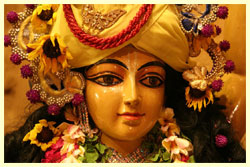 Vrindavana unless you’re in tune
with the Navadvipa mood. If you’re in tune with the mercy aspect of Lord Caitanya’s
sankirtana mission in Vrindavan, then it’s
as good as being in the Gaura-pita! I’m in
the Gaura-pita! I’m in the Gaura-pita and I’m also in the Krishna-pita. I have
two transcendental bodies. Yes, I have a transcendental body which is
fitting the service of Lord Gaura and I have a transcendental body fitting the
service of Radha and Krishna.” Vrindavana unless you’re in tune
with the Navadvipa mood. If you’re in tune with the mercy aspect of Lord Caitanya’s
sankirtana mission in Vrindavan, then it’s
as good as being in the Gaura-pita! I’m in
the Gaura-pita! I’m in the Gaura-pita and I’m also in the Krishna-pita. I have
two transcendental bodies. Yes, I have a transcendental body which is
fitting the service of Lord Gaura and I have a transcendental body fitting the
service of Radha and Krishna.”
The future of the
samadhi
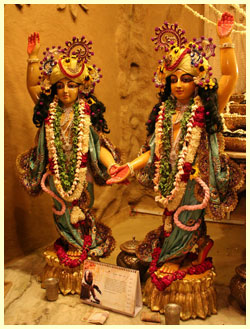 In another interview, Aindra Prabhu is saying about his
Nitai-Sacisuta that They're “the life and soul of the 24-hour
kirtana”. However, he was aware that the Gurukula building
will not last forever and that it probably won't be possible “to
make an Aindra's bhajan-kutir”. In another interview, Aindra Prabhu is saying about his
Nitai-Sacisuta that They're “the life and soul of the 24-hour
kirtana”. However, he was aware that the Gurukula building
will not last forever and that it probably won't be possible “to
make an Aindra's bhajan-kutir”.
The main problem with the
Gurukula building is that it hasn't been constructed with the
best kind of steel and due to the harsh climate of Vraja, it
becomes more and more dangerous to reside there, so much so that
the entire building will have to be pulled down in the year 2019. This means that his room (which is
currently also his samadhi) has to be shifted to another
place by April 2019 at latest in order to properly carry on the
worship.
Aindra Prabhu was aware of this fact and he expressed the desire
to have a place somewhere close to the ISKCON temple, i.e. in
Raman Reti. In one conversation in spring 2010, five months
before he passed away, this subject matter was brought up in a
discussion. You can read the transcription of this conversation
HERE.
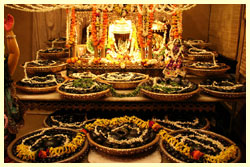 Besides his expressed desire for a place close to the temple,
there are other reasons which speak for the shifting of his
samadhi in due course of time. Besides his expressed desire for a place close to the temple,
there are other reasons which speak for the shifting of his
samadhi in due course of time.
According to the Vaishnava
tradition, the pinda (the samadhi-hill) should be
placed directly into the dust of the respective dhama. In
other words, a samadhi on the
2nd
floor of a
building is shastrically not approved of.
Another problem
which is being faced is that his present samadhi is
located in an area which is generally only accessible for souls
in a male body (the brahmacari-ashram). Ladies
were initially allowed to take darshan of Aindra
Prabhu's samadhi twice a year, but the darshan-timings
for ladies have unfortunately been abolished two years after his departure.
This
is not
to be seen with any other
samadhi
in Vaishnava history,
since the nature of each and every samadhi is that it's
open to everyone, no matter in what body that soul comes to
offer respects and prayers!
In our guru-parampara, samadhis have been
previously shifted in emergency cases. As an example serves
Gaura Kishora Dasa Babaji Maharaja's kevala-samadhi which
had to be moved from one side of the Ganges to the other (Mayapur)
due to a severe flood.
So
taking all these points into consideration, we're hoping to
be able to fulfill Aindra Prabhu's desire sooner or later.
If you feel inspired from the heart to help – in some way or
another - make his desire become true, then please don't
hesitate to approach us (CONTACT).
Hare Krishna!
|
Appearance and Disappearance
Day
Aindra Prabhu was born on March
12th 1953 at 4.28am in Arlington/Virginia (USA) and he
left this world on July 16th 2010 at 10.25pm in Sri
Vrindavan Dhama (India).
https://vicdicara.wordpress.com/2010/08/17/the-most-fortunate-horoscope-a-tribute-to-aindra/
Aindra Prabhu used to celebrate his birthday on Dvadasi after Papamocani
Ekadasi. After he passed away, there was a controversy concerning the Avirbhava Tithi of Aindra Prabhu. In a nutshell, there was a conflict between the South Indian and Nord Indian school of astrology and chart reading. Here comes the summary:
"Papamochani Ekadashi falls on the 11th day of the fading phase of the moon in Chaitra month (according to the North Indian Hindu calendar). This Ekadashi is the last one in all 24 Ekadashi fasts. As per the South Indian calendar, this Ekadashi falls on Krishna Paksha of the Phalguna month, whereas it is celebrated on the Krishna Paksha of the Chaitra month according to the North Indian calendar. Interestingly enough, this Ekadashi falls on the same day in both North and South Indian calendars."
His Thirubhava falls on Gaura-sashti of the Vamana month. This means that his
Thirubhava is to be observed on Sashti before Shayana
Ekadasi. People may think
it was on the 5th (Panchami) because that was the Tithi
for July 16th, 2010 in Vṛindavana. But considering
the time of day (10:25pm) when he left his body,
it is being marked as the sixth Tithi (Sashti).
Check here for the Tithi in your time zone:
http://www.purebhakti.com/resources/vaisnava-calendar-mainmenu-71.html
|
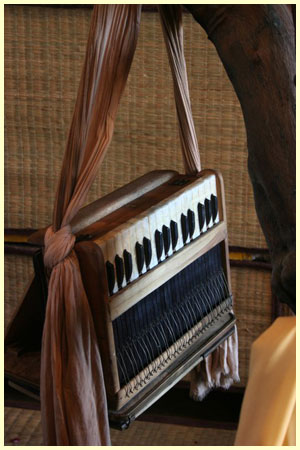
|



 Soon after arriving in Vrindavan in the 1980’s, Sripad Aindra
Prabhu moved into room No. 89 of the brahmacari-ashram
and continued to stay there for 24 years. His room depicts the
Vrindavan mood: Cow dung art (gobbar) decorates the walls
(personally done by him), the floor is covered with clay from
the Yamuna and the remnants of the original Tamal tree from the
temple courtyard are placed in its centre. Aindra Prabhu would
only leave his room to come down for his kirtana
services, Deity dressing services, to purchase bhoga for
his Deities, for going to the bathroom and very rarely for other
purposes. Most of his time, he spent in his room chanting many
rounds, writing on his book, studying Srila Prabhupada’s books and the Goswami
literatures as well as performing his personal Deity worship. It
was Aindra Prabhu's desire that his samadhi be placed
nearby his Deities and that the worship of over 2'000
saligrama-silas, his Nitai-Sacisuta and all his other
Deities go on as he was doing.
Soon after arriving in Vrindavan in the 1980’s, Sripad Aindra
Prabhu moved into room No. 89 of the brahmacari-ashram
and continued to stay there for 24 years. His room depicts the
Vrindavan mood: Cow dung art (gobbar) decorates the walls
(personally done by him), the floor is covered with clay from
the Yamuna and the remnants of the original Tamal tree from the
temple courtyard are placed in its centre. Aindra Prabhu would
only leave his room to come down for his kirtana
services, Deity dressing services, to purchase bhoga for
his Deities, for going to the bathroom and very rarely for other
purposes. Most of his time, he spent in his room chanting many
rounds, writing on his book, studying Srila Prabhupada’s books and the Goswami
literatures as well as performing his personal Deity worship. It
was Aindra Prabhu's desire that his samadhi be placed
nearby his Deities and that the worship of over 2'000
saligrama-silas, his Nitai-Sacisuta and all his other
Deities go on as he was doing.




